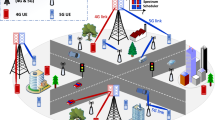Abstract
This paper investigates the outage and diversity performance in a cognitive radio (CR) network, in which data are transmitted through amplify-and-forward protocol. A fixed CR node is selected as relay to combat fading effect. The CR user transmits or relays data when the result of cooperative spectrum sensing indicates that primary user (PU) channel is free and the relay node stops performing the protocol as soon as the PU is detected to be active. A closed-form expression of outage probability for the CR network is calculated based on which diversity order is derived. The results show that the proposed scheme suffers a loss in diversity order. To compensate for this loss, a repetition-based scheme is proposed in a delay-insensitive system at the cost of the challenge in implementation. In this case, we evaluate the outage performance and the average transmit duration and then compare them with the ones in the delay-sensitive system. Asymptotic analysis is also presented to show the outage performance advantage of using a relay over the one without using it. The numerical results presented in the paper verify our analysis.
Similar content being viewed by others
References
Akyildiz I., Lee W., Vuran M., Mohanty S. (2006) Next generation/dynamic spectrum access/cognitive radio wireless networks: A survey. Computer Networks 50: 2127–2159
Ghasemi A., Sousa E. S. (2008) Spectrum sensing in cognitive radio networks: Requirements, challenges and design trade-offs. IEEE Communications Magazine 46(4): 32–39
Laneman J., Tse D., Wornell G. (2004) Cooperative diversity in wireless networks: Efficient protocols and outage behavior. IEEE Transactions on Information Theory 50(12): 3062–3080
Laneman J., Wornell G. (2003) Distributed space-time-coded protocols for exploiting cooperative diversity in wireless networks. IEEE Transactions on Information Theory 49(10): 2415–2425
Ghasemi, A., & Sousa, E. (2005). Collaborative spectrum sensing for opportunistic access in fading environments. In Proceedings of IEEE DySPAN (pp. 131–136), Baltimore, MD.
Sun, C., Zhang, W., & Letaief, K. (2007). Cluster-based cooperative spectrum sensing in cognitive radio systems. IEEE international conference on communications ICC (2007) (pp. 2511–2515).
Letaief K., Zhang W. (2009) Cooperative communications for cognitive radio networks. Proceedings of the IEEE 97(5): 878–893
Lee, K., & Yener, A. (2006). Spectrum-sensing opportunistic wireless relay networks: Outage and diversity performance. Fortieth asilomar conference on signals, systems and computers, 2006. ACSSC ’06. (pp. 206–210).
Suraweera, H., Smith, P., & Surobhi, N. (2008). Exact outage probability of cooperative diversity with opportunistic spectrum access. Communications workshops, 2008. ICC workshops’08. IEEE international conference on (pp. 79–84).
Krikidis I., Sun Z., Laneman J., Thompson J. (2009) Cognitive legacy networks via cooperative diversity. IEEE on Communications Letters 13(2): 106–108
Ganesan G., Li Y. (2007) Cooperative spectrum sensing in cognitive radio: Part I: Two user networks. IEEE Transactions on Wireless Communications 6(6): 2204–2213
Ganesan G., Li Y. (2007) Cooperative spectrum sensing in cognitive radio: Part II: Multiuser networks. IEEE Transactions on Wireless Communications 6(6): 2214–2222
Atapattu, S., Tellambura, C., & Jiang, H. (2009). Relay based cooperative spectrum sensing in cognitive radio networks. In Proceedings of IEEE GLOBECOM’09 (pp. 1–5).
Renzo M. D., Imbriglio L., Graziosi F., Santucci F. (2009) Distributed data fusion over correlated log-normal sensing and reporting channels: Application to cognitive radio networks. IEEE Transactions on Wireless Communications 8(12): 5813–5821
Simon M., Alouini M. (2005) Digital communication over fading channels (2nd ed.). Wiley, New York
Ma, J., & Li, Y. (2008). A probability-based spectrum sensing scheme for cognitive radio. ICC 2008 (pp. 3416–3420).
Anghel P., Kaveh M. (2004) Exact symbol error probability of a cooperative network in a Rayleigh-Fading enviroment. IEEE Transactions on Wireless Communications 3(5): 1416–1421
Yang Q., Xu S., Kwak K. (2008) Outage probability of cognitive radio with multiple receive antennas. IEICE Transactions on Communications E91-B(1): 85–94
Gradshteyn I., Ryzhik I. (2007) Table of integrals, series and products, 7th edn. Academic Press, San Diego, CA
Zheng L., Tse D. (2003) Diversity and multiplexing: A fundamental tradeoff in multiple-antenna channels. IEEE Transactions on Information Theory 49(5): 1073–1096
Wang Z., Giannakis G. (2003) A simple and general parameterization quantifying performance in fading channels. IEEE Transactions on Communications 51(8): 1389–1398
Author information
Authors and Affiliations
Corresponding author
Rights and permissions
About this article
Cite this article
Wang, Q., Yue, DW. & Lau, F.C.M. Outage Performance and Cooperative Diversity Under Amplify and Forward Relaying in Cognitive Radio Networks. Wireless Pers Commun 69, 891–914 (2013). https://doi.org/10.1007/s11277-012-0618-2
Published:
Issue Date:
DOI: https://doi.org/10.1007/s11277-012-0618-2




